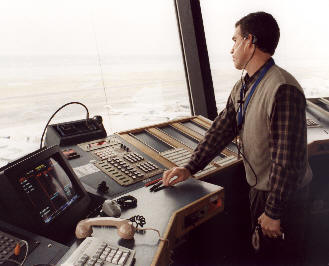
NEWSROOM
 |
NEWSROOM |
|
|
|
|
|||
|
FAA Solicits
Bids For NextGen Contracts Worth $7 Billion By Daniel Baxter |
||||
 |
December 5, 2009 - The FAA is soliciting bids from companies interested
in competing for NextGen support contracts with an approximate combined
value of $7 billion, the largest award in the agency’s history. Under
the umbrella awards, called System Engineering 2020 (SE2020), the FAA
will award as many as five separate contracts for research and
development and systems engineering work that will help the agency
deliver NextGen. The SE2020 contracts will be awarded to teams of companies, up to three of which will perform research and development work and two of which will perform systems engineering work. This work will complement and enhance major NextGen initiatives already under way, such as Automatic Dependent Surveillance – Broadcast, System Wide Information Management and Data Communications. Contract teams will focus on a series of operational capabilities, including Trajectory Based Operations, Collaborative Air Traffic Management and Reduced Weather Impact. |
|||
|
The Next Generation Air Transportation System (NextGen) is the name
given to a new National Airspace System due for implementation across
the
The air transportation system of the |
||||
|
NextGen consists of five elements:
1. Automatic dependent surveillance-broadcast (ADS-B). ADS-B will use
the Global Positioning System (GPS) satellite signals to provide air
traffic controllers and pilots with much more accurate information that
will help to keep aircraft safely separated in the sky and on runways.
Aircraft transponders receive GPS signals and use them to determine the
aircraft precise position in the sky. This and other data is then
broadcast to other aircraft and air traffic control. Once fully
established, both pilots and air traffic controllers will, for the first
time, see the same real-time display of air traffic, substantially
improving safety. The FAA will mandate the avionics necessary for
implementing ADS-B.
2. System Wide Information Management (SWIM). SWIM will provide a single
infrastructure and information management system to deliver high
quality, timely data to many users and applications. By reducing the
number and types of interfaces and systems, SWIM will reduce data
redundancy and better facilitate multi-user information sharing. SWIM
will also enable new modes of decision making as information is more
easily accessed.
3. Next Generation Data Communications. Current communications between
aircrew and air traffic control, and between air traffic controllers,
are largely realised through voice communications. Initially, the
introduction of data communications will provide an additional means of
two-way communication for air traffic control clearances, instructions,
advisories, flight crew requests and reports. With the majority of
aircraft data link equipped, the exchange of routine controller-pilot
messages and clearances via data link will enable controllers to handle
more traffic. This will improve air traffic controller productivity,
enhancing capacity and safety.
4. Next Generation Network Enabled Weather (NNEW). Seventy percent of
NAS delays are attributed to weather every year. The goal of NNEW is to
cut weather-related delays at least in half. Tens of thousands of global
weather observations and sensor reports from ground-, airborne- and
space-based sources will fuse into a single national weather information
system, updated in real time. NNEW will provide a common weather picture
across the national airspace system, and enable better air
transportation decision making.
5. NAS Voice Switch (NVS). There are currently seventeen different voice
switching systems in the NAS, some in use for more than twenty years.
NVS will replace these systems with a single air/ground and
ground/ground voice communications system.
With NextGen, many pilots and dispatchers will be able to select their
own, usually direct flight paths, rather than follow the existing
interstate highway-like grid in the sky. Each airplane will transmit and
receive precise information about the time at which it and others will
cross key points along their paths. Pilots and air traffic managers on
the ground will have the same precise information, transmitted via data
communications.
Major demand and capacity imbalances will be worked collaboratively
between the FAA air traffic managers and flight operations. The
increased scope, volume and widespread distribution of information by
SWIM, will improve decision making and let more civil aviation
authorities participate.
The impact of weather on flight operations will be reduced through the
use of improved information sharing, new technology to sense and
mitigate the impacts of the weather, to improve weather forecasts and
decision making. Better forecasts, coupled with greater automation, will
minimize airspace limitations and traffic restrictions.
The new procedures of NextGen will improve airport surface movements,
reduce spacing and separation requirements, and better manage the
overall flows into and out of busy airspace, and to provide maximum use
of busy airports. |
| ©AvStop Online Magazine Contact Us Return To News |
|